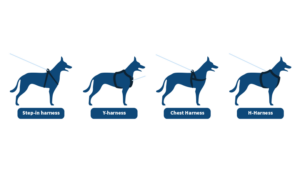How to choose the perfect harness for your dog?
Written by Milou |
A relaxing walk with your dog starts with the right gear. And a harness is definitely part of that. A dog harness offers many benefits for both you and your dog. In addition to comfort, it also provides a level of safety during your walks. There are many different types of harnesses available in various models, colours, and sizes. That’s great – but which one is the most suitable, and what should you look for when choosing? We’ll walk you through the most common types!

Dog walking harness
When buying a dog harness, it’s important to look at what fits your dog best and what material is used. Take your dog’s weight and build into consideration. The look and purpose of the harness may also influence your choice, but your dog’s comfort should always come first. That way, both of you can enjoy your walks to the fullest!
Unlike a collar, a harness distributes pressure evenly across your dog’s back, chest, and neck. This helps to prevent back and neck issues and increases overall comfort. When choosing a dog harness, it’s best to define your intended use beforehand in order to make the right choice.
Reasons to choose a dog harness:
- Relaxed walks together with your dog
- Preventing escapes
- Injury prevention
- Your dog has a sensitive back, neck and/or shoulders
- Comfort and safety
- Control
- Sports
- Car travel
Once you’ve determined the purpose, you can more easily find a harness that fits that specific need.
What should you consider when buying a dog harness?
There are several important points to keep in mind when choosing a suitable harness for your dog.
A proper fit
Every dog is different, and so is the fit. Which fit is best for your dog depends on their build and your personal preferences. A well-fitting harness:
- Fits snugly around your dog’s chest, with space for one finger between the harness and the skin on both sides.
- Distributes pulling force across the dog’s body during walks.
- Puts no pressure on the windpipe.
- Should not chafe under the armpits.
- Leaves the shoulders free. This prevents overloading the muscles and tendons in the neck and shoulders and reduces rubbing or pressure marks on the skin.
- Has a leash attachment on the back that doesn’t extend past the ribs. A properly fitting dog harness leaves the ribcage free so the lungs can expand fully.
The material
The material of your ideal harness may influence your decision. There are many types to choose from: padded or unpadded, with or without fleece lining. Made of leather, nylon, neoprene, 3D mesh, or polyester. If you want a harness that’s weather-resistant and suitable for swimming, it’s best to choose a washable material. If your dog has a thin coat, a thicker lining is especially important.




